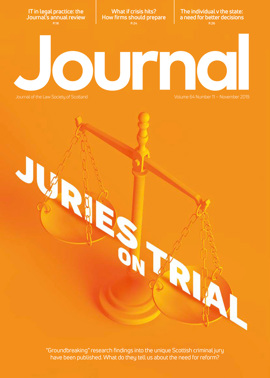Justice, but which way?

It was the largest and most realistic piece of research of its kind ever undertaken in the United Kingdom, and a groundbreaking study into jury behaviour. It was commissioned as recommended by Lord Bonomy in his report on safeguards that might be needed if the corroboration rule were to be abolished in criminal cases. It involved a total of 969 individuals in mock trials held over a five-month period. So what light does the Scottish jury research study throw on the effects of the unique features of the Scottish system, and in particular the not proven verdict? And what might it mean for future policy?
Carried out by Professors James Chalmers and Fiona Leverick (University of Glasgow) and Vanessa Munro (University of Warwick), with Ipsos MORI Scotland, the research was a carefully constructed exercise. Differently constituted, and differently directed, juries of volunteers, as nearly as possible demographically representative of the eligible population, had to view one of two simulated trials, with Lord Bonomy presiding but actors playing the accused, witnesses and legal representatives. One was a rape case; the other an assault with a plea of self defence. Both were deliberately finely balanced cases.
Sixty-four juries, comprised of 863 individuals, were equally divided between those of 12 and those of 15 members; those told to seek a unanimous decision and those allowed a majority verdict; and those offered the standard three Scottish verdicts and those given only the options of guilty or not guilty. Thus four juries with each possible combination of features viewed each trial.
What was found?
All the jury deliberations were recorded and analysed along with questionnaires completed by each juror before and after they discussed their verdict. The report makes no policy recommendations, but presents its findings as a basis for policy development. These included:
- the number of jurors involved revealed significant differences at individual level, and while it is not easy to translate these into jury level findings, they indicate the likelihood of particular features tilting a jury one way or the other;
- a 12 person jury led to more jurors being involved in discussions, and perhaps to changing their view to accord with the majority;
- seeking unanimity, or something close to it, might lead to more acquittals where a trial is finely balanced;
- most three verdict juries that acquitted chose not proven rather than not guilty; and removing the not proven option might result in more guilty verdicts. Some jurors thought not proven meant the accused could be tried again;
- the combination of features that produced the most convictions was a 15 person, simple majority, two verdict jury;
- the combination that produced fewest convictions was a 12 person, unanimous, three verdict jury.
Significantly, potential misunderstandings of legal issues arose relatively frequently. Apart from the effect of a not proven verdict, these included the meaning of beyond reasonable doubt, and the effect of establishing self defence, on which the juries had been directed.
This suggests a need to consider whether additional guidance (such as written routes to verdict or written reminders of key legal principles) would be helpful to aid jurors’ discussion”, the report summary observes.
What will the Government do?
Cabinet Secretary for Justice, Humza Yousaf, answering press questions at the launch, was at pains to emphasise that discussions are only beginning on the implications of the results.
“I think it would be hugely important to try to build political consensus where we can, and try to gather views from what people think the research tells them,” he stated. “Then it will be for the Government to come forward with potential options for reform, and what I have said is that nothing is off the table, every option is up for consideration, and central to those discussions will undoubtedly be whether we should move from a three verdict to a two verdict system.”
From this month until February, a “targeted and focused” consultation will take place with those principally interested in the research: the legal profession, justice and victim organisations. And the opposition parties: recalling the heat generated by the proposed abolition of corroboration, Yousaf is keen to try and build political consensus.
What will happen after the first phase will be determined by those discussions, he added – anything from substantial changes going through the full consultation process, to minor tweaks. He was not going to be drawn: when it was put to him that not proven was now “on life support”, he replied that while he was giving “serious consideration” to moving to a two verdict system, that verdict would not necessarily be the one to drop out.
Conversely, to the suggestion that the somewhat limited variations within the results indicated that the alleged defects in the Scottish system were overplayed by some critics, he agreed that there was no issue with the integrity of the justice system, but was not buying any argument that because things had been done a certain way for centuries, they must always be done thus. “So I will, of course, look to the unique characteristics of the Scottish justice system, but equally I always have said as Cabinet Secretary for Justice that I am led by the evidence. And the evidence we now have is weighty and comprehensive, therefore that should be the basis for conversations moving forward.”
A wary profession
If he is to secure consensus from the legal profession to significant change, the first thing Yousaf will have to overcome is a suspicion that the principal motive is to secure more convictions. “Central to our system of criminal justice is the right to a fair trial,” commented Julia McPartlin, President of the Edinburgh Bar Association. “It is not the purpose of our system to secure convictions. Therefore, I am wary about how the findings might be used or indeed misused.”
Noting the admitted limitations of the research findings, she adds: “The numbers used are too small to be statistically significant. Therefore, whatever your perspective, this research cannot justify any change in our jury model.”
For Martin Morrow, solicitor advocate with MTM Defence Lawyers in Falkirk, “the cynic in me thinks this research is designed to lead to the abolition of the not proven verdict” – not something, in his view, with which politicians should be interfering, “particularly if I sense they are playing to a gallery”.
Anyone who studies the Jury Manual, he believes, would take the view that a two verdict system would offer the choice of proven/not proven beyond reasonable doubt on the evidence: it is referring to guilty/not guilty that introduces confusion, when the only time not guilty is mentioned is in the context of the verdicts available. “If they must meddle, let them remove the verdicts of guilty and not guilty.”
More fundamentally, Morrow believes the research “calls into question the continued existence of trial by jury”. That is because although the Appeal Court has repeatedly stated its belief that juries can be relied on to grasp directions, for example on the burden of proof, or corroboration, or the Moorov doctrine, the report “tells us the properly directed jury struggle to comprehend the not guilty and not proven verdicts” – casting doubt on their ability to apply other more complex rules correctly.
First move?
Would matters not be improved by providing the jury with written directions? Yes, and dramatically, according to Stuart Munro of Livingstone Brown in Glasgow, another who is alarmed at the number of jurors failing to grasp basic concepts such as the presumption of innocence. “One way of helping jurors understand the legal framework is by providing them with written directions. These are increasingly common in England; initial judicial reluctance appears to have been largely overcome. Research there overwhelmingly suggests that jurors who are provided with written directions find them beneficial.”
Another aid, he observes, is the “route to verdict”, a flowchart summarising the approach the jury should take in a particular case.
A published example was the case of the cricketer Ben Stokes, whose jury were given “a simple sheet of A4, with questions and decision arrows, that succinctly set out the issues the jury had to address. Its publication helped the public see why the jury had reached what at first appeared to be a surprising verdict”. In Munro’s view, “It is difficult to see why we should not be moving in this direction.” And it could be done quickly, unlike the more fundamental changes that might be considered.
McPartlin agrees that written directions might be beneficial. Overall, however, she takes the view that the research is deficient in terms of its size and remit to justify any significant change to our present model. “One glaring omission is that none of the jury sets were given a choice of proven/not proven verdicts. What the research did tend to suggest was that jurors preferred to acquit via not proven rather than not guilty where evidence is finely balanced. I suggest that is an appropriate use of the not proven verdict.”
She concludes: “The limitations of the research are such that no change to the three verdict model should be made based on these findings.”
Munro is a little more positive: “Criminal justice is a complex system: a change in one part will have implications elsewhere. Any reform – whether to change the size or role of juries, or to remove a verdict – needs to be based on analysis of as much evidence as possible. The mock jury study will undoubtedly help in that process.”
Yousaf, it should be recalled, is also under pressure from those who see the present system as letting down rape victims in particular, and are impatient for change. He stated in terms that it would be wrong to view the research through the “prism” of what increases or reduces conviction rates, but equally expressed his concern over rape cases. There seems little doubt that the research report will be used as a basis for action of some sort, and the profession would do well to engage on that basis.
To read the research report, click here to visit gov.scot
Professors Chalmers and Leverick blog on the research in the Society’s platinum blog series






